STS-125 Launch
Monday, May 11th, 2009Time to tune up the Hubble…
Time to tune up the Hubble…

Not sure if this is a 50-1 longshot, but President Obama will be reviewing the new lunar mission, via Florida Today:
President Barack Obama will order a comprehensive review of NASA’s plans to return astronauts to the moon when the agency’s proposed 2010 budget is released Thursday.
Expected to last 60 to 90 days, the independent review will examine designs for the launch and exploration vehicles proposed for use by the Constellation program and the timeframe for flying lunar missions, according to sources familiar with the budget planning but not authorized to speak publicly about it.
Norman Augustine, a retired chairman and CEO of Lockheed Martin Corp. and former president of the American Institute of Aeronautics and Astronautics, is the likely candidate to lead the study, the sources said.
Augustine could speak publicly about the review as early as Friday.
Current NASA plans call for missions to the moon by 2020, a target set by the space exploration vision established in 2004 by former President George W. Bush.
But the agency last month put on hold contract awards for preliminary designs of the Ares V heavy-lift rocket and Altair lunar lander, pending release of the budget.
We shouldn’t abandon plans to visit the Moon again. It’s good for NASA and the USA.
Well if I had money
I tell you what I’d do
I’d go downtown and buy me a Mercury or two
Crazy bout a Mercury
I’m gonna buy me a Mercury
And cruise it up and down the road

Ford’s Mercury brand did make some cool cars, back in the day. I remember their product placements in the Hawaii Five-O TV series. Which, to this day, has law enforcement types exclaiming "book em , Danno!" I can’t remember the last time Mercury had a popular model (always liked the ’67 Cougar).
You know who’s got money for a Mercury? NASA! The MESSENGER spacecraft (MErcury Surface, Space ENvironment, GEochemistry, and Ranging) just did a second fly-by of the planet Mercury found there’s more to it:
Analyses of data from the MErcury Surface, Space ENvironment, GEochemistry, and Ranging (MESSENGER) spacecraft’s second flyby of Mercury in October 2008 show that the planet’s atmosphere, magnetosphere, and geological past are all characterized by much greater levels of activity than scientists first suspected.
On October 6, 2008, the probe flew by Mercury for the second time, capturing more than 1,200 high-resolution and color images of the planet unveiling another 30 percent of Mercury’s surface that had never before been seen by spacecraft and gathering essential data for planning the remainder of the mission.
“MESSENGER’s second Mercury flyby provided a number of new findings,” says MESSENGER Principal Investigator Sean Solomon at the Carnegie Institution of Washington. “One of the biggest surprises was how strongly the planet’s magnetospheric dynamics changed from what we saw during the first Mercury flyby in January 2008. Another was the discovery of a large and unusually well preserved impact basin that was the focus for concentrated volcanic and deformational activity. The first detection of magnesium in Mercury’s exosphere and neutral tail provides confirmation that magnesium is an important constituent of Mercury’s surface materials. And our nearly global imaging coverage of the surface after this flyby has given us fresh insight into how the planet’s crust was formed.”
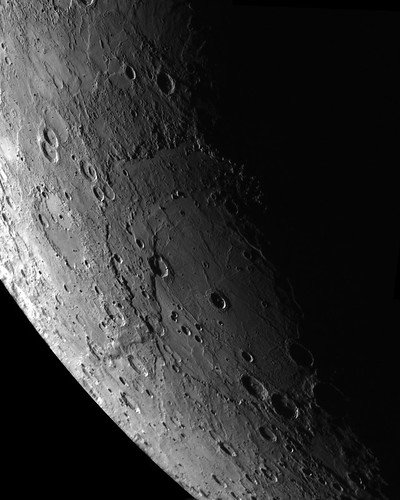
Nice animation…
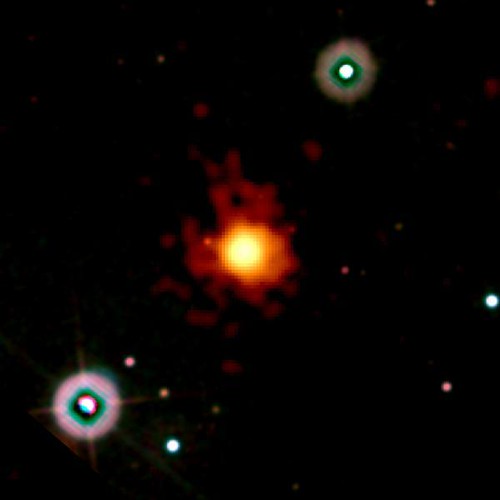
Tommy Chong of Cheech & Chong said it best: "Far out, man!"
I wonder if somebody at NASA’s Goddard Space Flight Center said something similar about this blast from the past, maybe 13 billion light years away:
NASA’s Swift satellite and an international team of astronomers have found a gamma-ray burst from a star that died when the universe was only 630 million years old, or less than five percent of its present age. The event, dubbed GRB 090423, is the most distant cosmic explosion ever seen.
"Swift was designed to catch these very distant bursts," said Swift lead scientist Neil Gehrels at NASA’s Goddard Space Flight Center in Greenbelt, Md. "The incredible distance to this burst exceeded our greatest expectations — it was a true blast from the past."
At 3:55 a.m. EDT on April 23, Swift detected a ten-second-long gamma-ray burst of modest brightness. It quickly pivoted to bring its ultraviolet/optical and X-ray telescopes to observe the burst location. Swift saw a fading X-ray afterglow but none in visible light.
"The burst most likely arose from the explosion of a massive star," said Derek Fox at Pennsylvania State University. "We’re seeing the demise of a star — and probably the birth of a black hole — in one of the universe’s earliest stellar generations."
Gamma-ray bursts are the universe’s most luminous explosions. Most occur when massive stars run out of nuclear fuel. As their cores collapse into a black hole or neutron star, gas jets — driven by processes not fully understood — punch through the star and blast into space. There, they strike gas previously shed by the star and heat it, which generates short-lived afterglows in many wavelengths.
"The lack of visible light alone suggested this could be a very distant object," explained team member Edo Berger of Harvard University.
Beyond a certain distance, the expansion of the universe shifts all optical emission into longer infrared wavelengths. While a star’s ultraviolet light could be similarly shifted into the visible region, ultraviolet-absorbing hydrogen gas grows thicker at earlier times. "If you look far enough away, you can’t see visible light from any object," he noted.
Within three hours of the burst, Nial Tanvir at the University of Leicester, U.K., and his colleagues reported detection of an infrared source at the Swift position using the United Kingdom Infrared Telescope on Mauna Kea, Hawaii. "Burst afterglows provide us with the most information about the exploded star and its environs," Tanvir said. "But because afterglows fade out so fast, we must target them quickly."
At the same time, Fox led an effort to obtain infrared images of the afterglow using the Gemini North Telescope on Mauna Kea. The source appeared in longer-wavelength images but was absent in an image taken at the shortest wavelength of 1 micron. This "drop out" corresponded to a distance of about 13 billion light-years.
Here’s a video of what a gamma ray burst would look like up-close (Credit: NASA/Swift/Cruz deWild):

That’s the name NASA selected for the International Space Station’s Node 3.
As a compromise, NASA is offering to name the new treadmill "C.O.L.B.E.R.T." (Combined Operational Load Bearing External Resistance Treadmill).
Yeah, I’m thinking of the Jetsons, too…

That’s right, MARS: the Mid-Atlantic Regional Spaceport, located on Wallops Island in Virginia. The Wallops Research Range is America’s oldest continuously-operating rocket launch range. It’s been around for more than 60 years and has supported more than 16,000 flight events.
On 5 May 2009, it’s leading the launch of a Minotaur 1 rocket carrying three payloads. The summary, via delmarvanow.com:
The spacecraft — consisting of an ATK Space Systems satellite bus and Tactical Satellite-3, which carries a trio of experiments — will be taken into space by an Orbital Sciences Corp. Minotaur I rocket.
The four-stage rocket includes two taken from retired Minuteman intercontinental ballistic missiles and two from Orbital’s Pegasus booster.
"Obviously, the project has much to do in these next few weeks leading up to lift off, but we now have a firm end date to get on orbit and begin the fun experiment phase," TacSat-3’s program manager Thomas Cooley said about problems encountered earlier in the project with some of the spacecraft’s components.
The main experiment aboard the satellite, ARTEMIS HSI, was developed by Raytheon Co. It is designed to quickly supply military commanders in the war theater with target detection and identification information, along with information about battlefield preparation and combat damage.
A second payload on TacSat-3 is the Office of Naval Research’s Satellite Communications Package, which will collect data from sea-based buoys and transmit it back to a ground station.
A third experiment, the Air Force Research Laboratory’s Space Avionics Experiment, is described in a prepared release from the Air Force as "plug-and-play avionics to advance the technology of rapid spacecraft integration and help enable the responsive space vision."
All three payloads have been tested at Kirtland Air Force Base in New Mexico and final checks of the flight software have been completed in preparation for the May launch.
"Our program team never gave up, and establishment of the launch date serves as a testimony to their dedication, determination and duty to making TacSat-3’s mission a success,” Cooley said.
The spacecraft is now at MARS, where it will be joined with the launch vehicle.
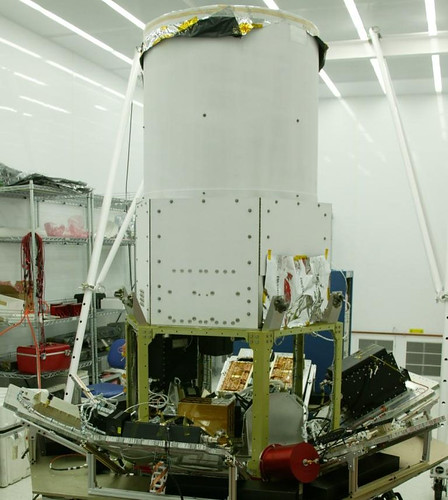
Expect the launch to be webcast here.
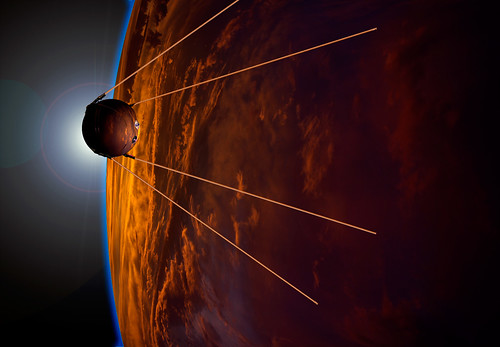
Cool, via Fox News:
In 1970, Marshall Kaplan, then an aerospace engineering professor at Penn State, had a peculiar dream — he wanted to retrieve Sputnik, the world’s first orbiting satellite, from space.
Sputnik had been launched by the Russians in 1957, and by 1970 it was no longer operational. Kaplan wanted to go get it.
NASA had never considered space retrieval before, but it thought it was a good idea. Kaplan got the job, but it didn’t work out — because the time frame was too short. Sputnik, nearing the end of its life cycle, was already about to deorbit — the technical term for what happens when an object circling the Earth gets close enough to be caught in gravity and burned to cinders in the atmosphere.
But that didn’t mean Kaplan needed a new line of work.
In fact, his work was just beginning.
Have you ever seen the Sputnik launch from 1957? Here’s the footage:
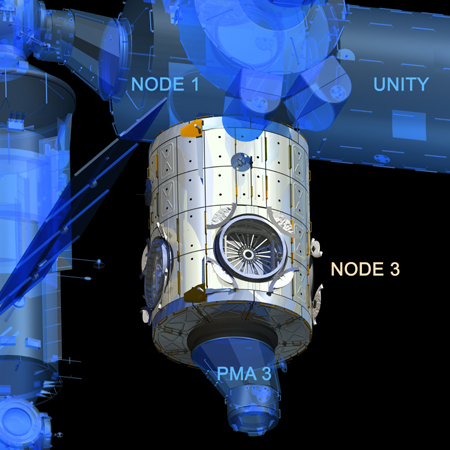
Apparently, most people wrote in with the name "Colbert," and generated more than 40,000 votes than NASA’s suggested "Serenity." It’s not news, it’s CNN:
Fans of "The Colbert Report" made "Colbert" the No. 1 submission in a NASA contest to name a new wing of the international space station.
Still, NASA reserves the right to name the wing of the space station and says it will not make a final decision on the matter until next month.
"Colbert" pulled in 230,539 of the more than 1.1 million submissions in the contest, according to NASA spokesman John Yembrick. Video Watch how Colbert urged his viewers to vote »
NASA’s suggestion for the wing, "Serenity," came in second, with slightly more than 190,000 votes, he said.
Yembrick said NASA had not yet decided what to name Node 3 — a connecting module and its cupola — that will be installed on the space station.
He said NASA would likely put "Colbert" a "little higher" in the space agency’s consideration because of the high number of submissions but emphasized that the decision would likely not be made until next month.
The contest rules say NASA reserves the right to "ultimately select a name in accordance with the best interests of the agency. … Such name may not necessarily be one which is on the list of voted-on candidate names."
Other rooms on the space station are named Unity, Harmony and Destiny.
More from the Houston Chronicle:
Didn’t NASA realize that the Colbert Nation pounces on any opportunity to vote for the star of Comedy Central’s The Colbert Report when a naming contest is in the works?
The name “Colbert” won the agency’s online contest to name a new room on the International Space Station. It’s not the first victory for Stephen Colbert, although it’s not yet known whether NASA will honor the write-in campaign.
Other namesakes (some were bestowed without a vote) include:
• Steagle Colbeagle the Eagle: Saginaw Spirit minor-league hockey team mascot in Michigan.
• Stephen Jr.: Bald eagle born at the San Francisco Zoo.
• Stelephant Colbert: Elephant seal that roams near Santa Cruz, Calif.
• Stephanie Colburtle: Leatherback in the Great Turtle Race from Costa Rica to the Galapagos Islands.
• Aptostichus Stephencolberti: Species of trapdoor spider.
• Bridge over Danube: Colbert earned a you-win document in 2006 from Hungarian officials who then said the bridge could only be named after a deceased person. It is now called the Megyeri Bridge.
• Air Colbert: The Virgin America plane was christened a few weeks before Colbert and owner Richard Branson doused each other with water during an August 2007 meeting on The Colbert Report.
• The Colbert Report fans don’t always win. In a naming contest earlier this month for a park in St. Charles, Mo., Colbert Park came in second. The winner was Vogt Brothers Park, in honor of the land’s former owners.
This is not an April Fool’s Day prank…
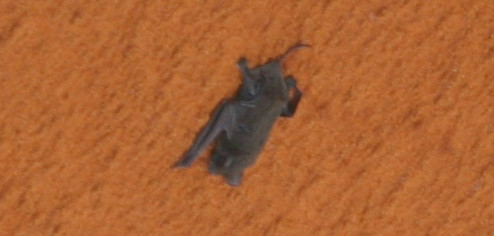
Major League baseball is being played all over Florida lately. But there’s the story of the real bat that clung to Space Shuttle’s external tank during launch that’s got people talking:
A bat that was clinging to space shuttle Discovery’s external fuel tank during the countdown to launch the STS-119 mission remained with the spacecraft as it cleared the tower, analysts at NASA’s Kennedy Space Center concluded.
Based on images and video, a wildlife expert who provides support to the center said the small creature was a free tail bat that likely had a broken left wing and some problem with its right shoulder or wrist. The animal likely perished quickly during Discovery’s climb into orbit.
Because the Merritt Island National Wildlife Refuge coexists inside Kennedy Space Center, the launch pads have a number of measures available, including warning sirens, to deter birds and other creatures from getting too close. The launch team also uses radar to watch for birds before a shuttle liftoff.
Nevertheless, the bat stayed in place and it was seen changing positions from time to time.
Launch controllers spotted the bat after it had clawed onto the foam of the external tank as Discovery stood at Launch Pad 39A. The temperature never dropped below 60 degrees at that part of the tank, and infrared cameras showed that the bat was 70 degrees through launch.
The final inspection team that surveys the outside of the shuttle and tank for signs of ice buildup observed the small bat, hoping it would wake up and fly away before the shuttle engines ignited.
It was not the first bat to land on a shuttle during a countdown. Previously, one of the winged creatures landed on the tank during the countdown to launch shuttle Columbia on its STS-90 mission in 1998.
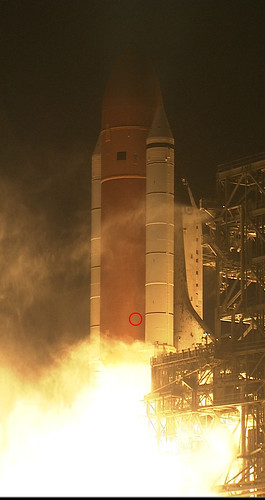
Alas, poor batstronaut, I knew him well.